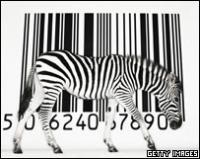







|
News and Information
Science intends to tag all life
| February 10, 2005 |

By Jonathan Amos
BBC News science reporter
Zebra against a barcode (Tim Flach/Getty)
Science is engaged in a huge stocktaking exercise
Scientists are to establish a giant catalogue of life - to, in effect, "barcode" every species on Earth, from tiny plankton to the mighty blue whale.
Initial projects will focus on birds and fish, recording details in their genetic make-up that can be used to tell one life form from another.
The initiative was launched in London at the International Conference for the Barcoding of Life.
Researchers concede it will take many years to complete the task.
"About 1.7 million species are known - we suspect there are anything from 10-30 million species on Earth," explained Dr Richard Lane, director of science at London's Natural History Museum.
"We have discovered that it is quite possible to have a short DNA sequence that can characterise just about every form of life on the planet."
Opening up
At the cost of about £1 ($1.80) per genetic test, many specimens for each species will now be analysed to obtain their barcode information.
This data will then be put into a giant database which the Consortium for the Barcode of Life (CBOL) hopes can be used to link off to all the knowledge acquired by science on particular organisms.
DNA - BARCODING LIFE
Graphic, BBC
The double-stranded DNA molecule is held together by chemical components, or bases
Adenine (A) bonds with thymine (T); cytosine(C) bonds with guanine (G)
Written in these "letters" are genes - starting templates that drive the production of proteins which build and maintain an organism's body
Barcoding records the order of DNA letters in a particular gene found in mitochondria, the "power units" in cells
This DNA changes rapidly over time as species evolve
These differences can be used to distinguish species
And just as one might Google a species name today to find pictures or a description of an individual insect, the time may come when we have Star Trek-style mobile computers that can read off barcodes and access species information in the field.
"It's like a policeman who sees a car breaking the law and all he's got is the licence plate number - but with that number he's got the owner and when the car was bought," Professor Dan Janzen, from the University of Pennsylvania, US, said.
"And that's what a barcode is - it's that thing that links you to the body of information the taxonomists, the natural historians and ecologists have been accumulating for 200 years."
The consortium pulls together a range of world museums, zoos, research organisations and companies concerned with taxonomy and biodiversity.
DNA barcodes should make species recognition in the field much easier, especially where traditional methods are not practical. In addition, species identification should become more reliable, particularly for non experts.
Just knowing every species on Earth would help answer some fundamental questions in ecology and evolution. And with this information we would get very much better polices to manage and conserve the world around us.
Short code
Dr Scott Miller, the chairman of the CBOL, added: "DNA barcoding will make a huge difference to our knowledge and understanding of the natural world.
"The Barcode of Life initiative aims to complement existing taxonomic practice to build on it and expand its power and use."
The segment of DNA to be used in the project is found in a gene known as cytochrome c oxidase I, or COI.
Darwin Centre technician holds a specimen (PA)
Many museum-stored specimens will be used for barcoding
This is involved in the metabolism of all creatures but is coded slightly differently in each one of them.
In humans, for example, COI barcodes differ from one another by only one or two DNA "letters" out of 648; while we differ from chimpanzees at about 60 locations, and in gorillas by about 70.
Wednesday saw the announcement at the London conference of a project to get comprehensive barcode data on all known fish types - currently thought to number 15,000 marine and 8,000 freshwater species.
The bird project will list the world's 10,000 known avian species.
A third project will genetically label the 8,000 kinds of plants in Costa Rica, Central America.
Some doubts
It has to be said that not all of the science community shares the unrestrained enthusiasm of the barcoders.
Some researchers are concerned that taxonomic skills that have traditionally been used to catalogue individual species may suffer - fewer and fewer students now take up the discipline, especially in Western universities.
Doubt has also been expressed that the COI approach will prove as reliable in distinguishing species as is claimed.
Insects on display (Natural History Museum)
Insects are among the dominant lifeforms on the planet
This view is shared by butterfly expert James Mallet, from University College London. Although he supports the project, Professor Mallet thinks it may struggle in several settings, such as when a new or hybrid species has just emerged in a population.
"I just wish it hadn't been called barcoding because this should mean things are identical - for any retail product that's how you recognise them," he said.
"This is not true of mitochondrial DNA and in an evolutionary setting where species grade into other species, this is a lot more tricky.
"Closely related species are going to give you more difficulty and the more data you have, including DNA data - and DNA data is very powerful - the better." |
Source: www.bbc.com |
| http://news.bbc.co.uk/2/hi/science/nature/4251309.stm |
|
| Support Caprivi Freedom |
Fill out the form below to become a member of this site and receive our regular newsletter.
|

|

